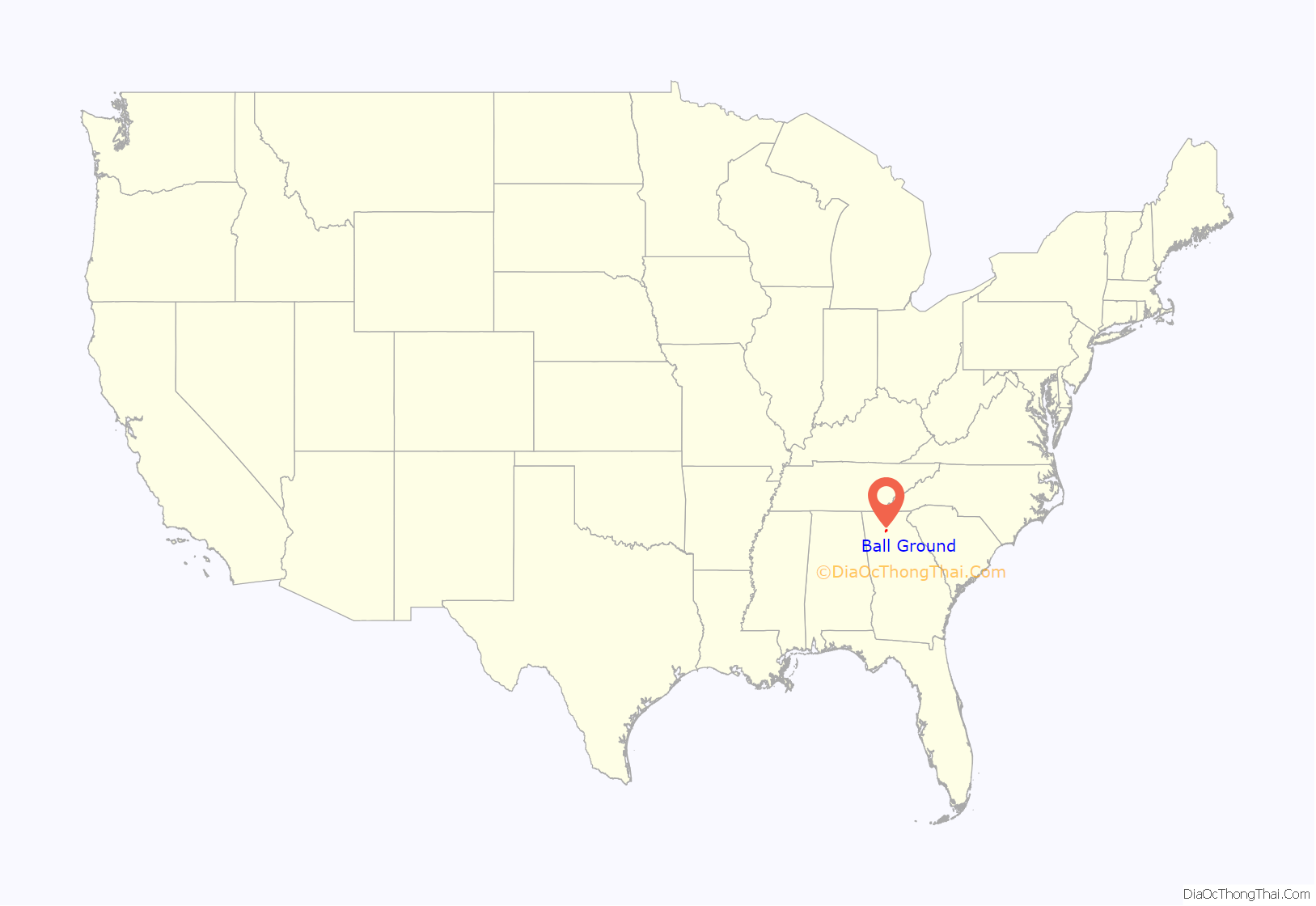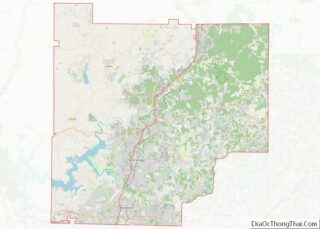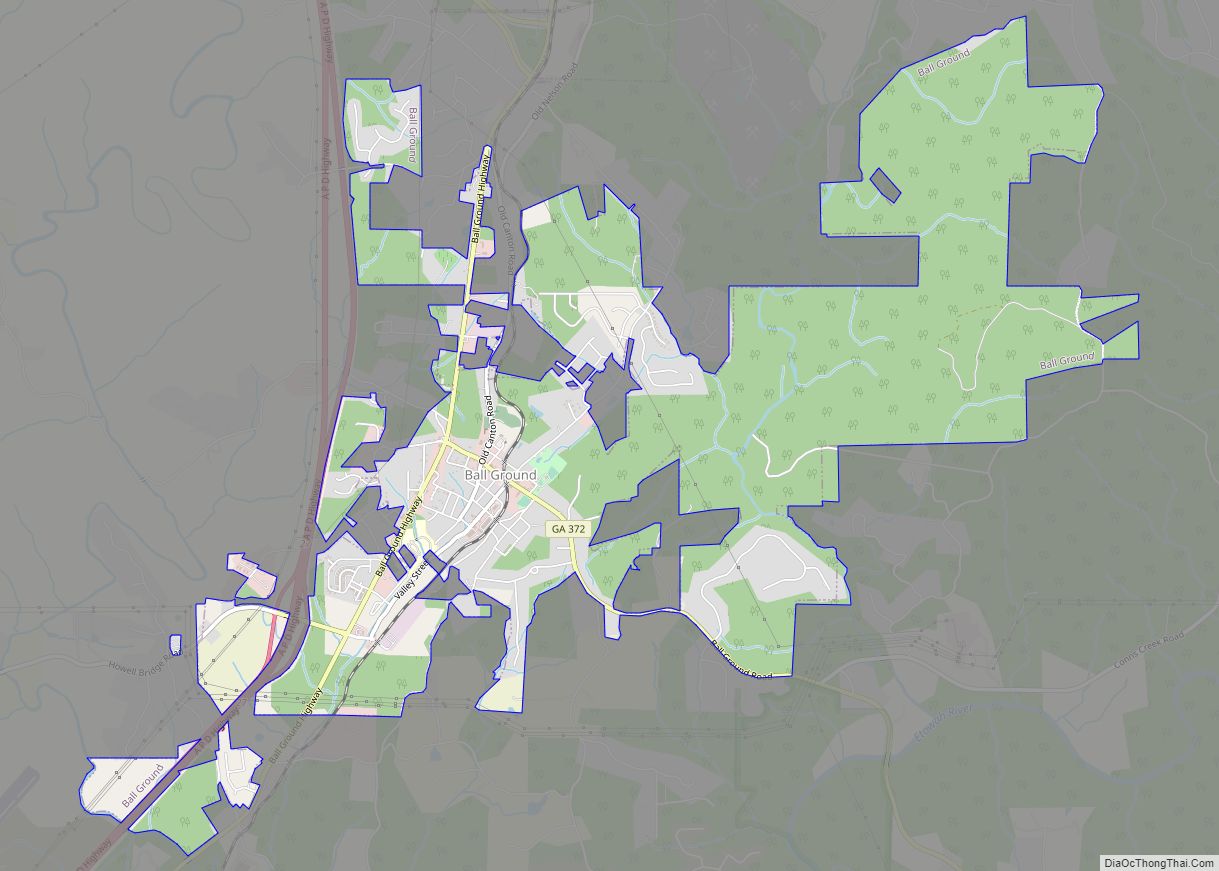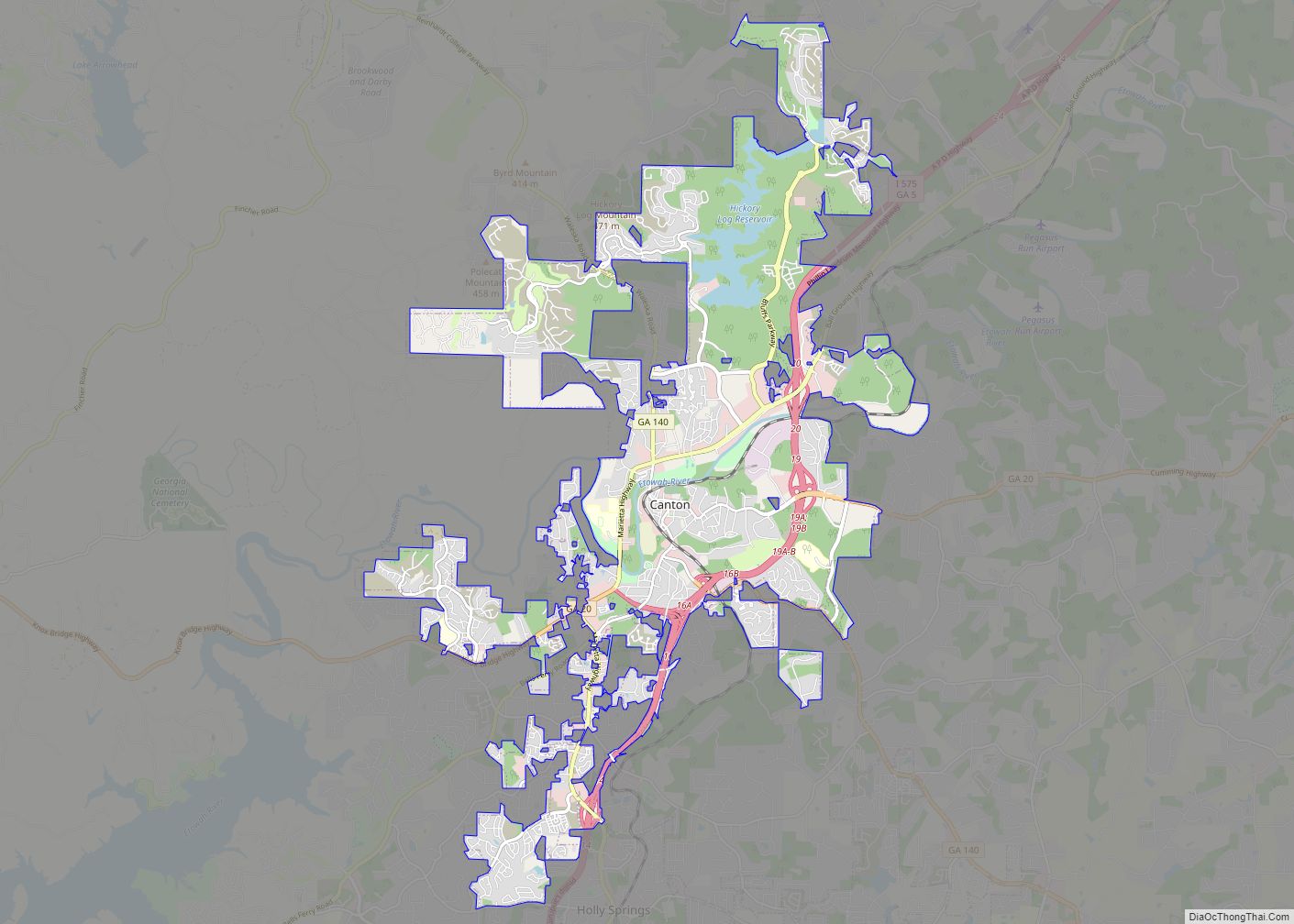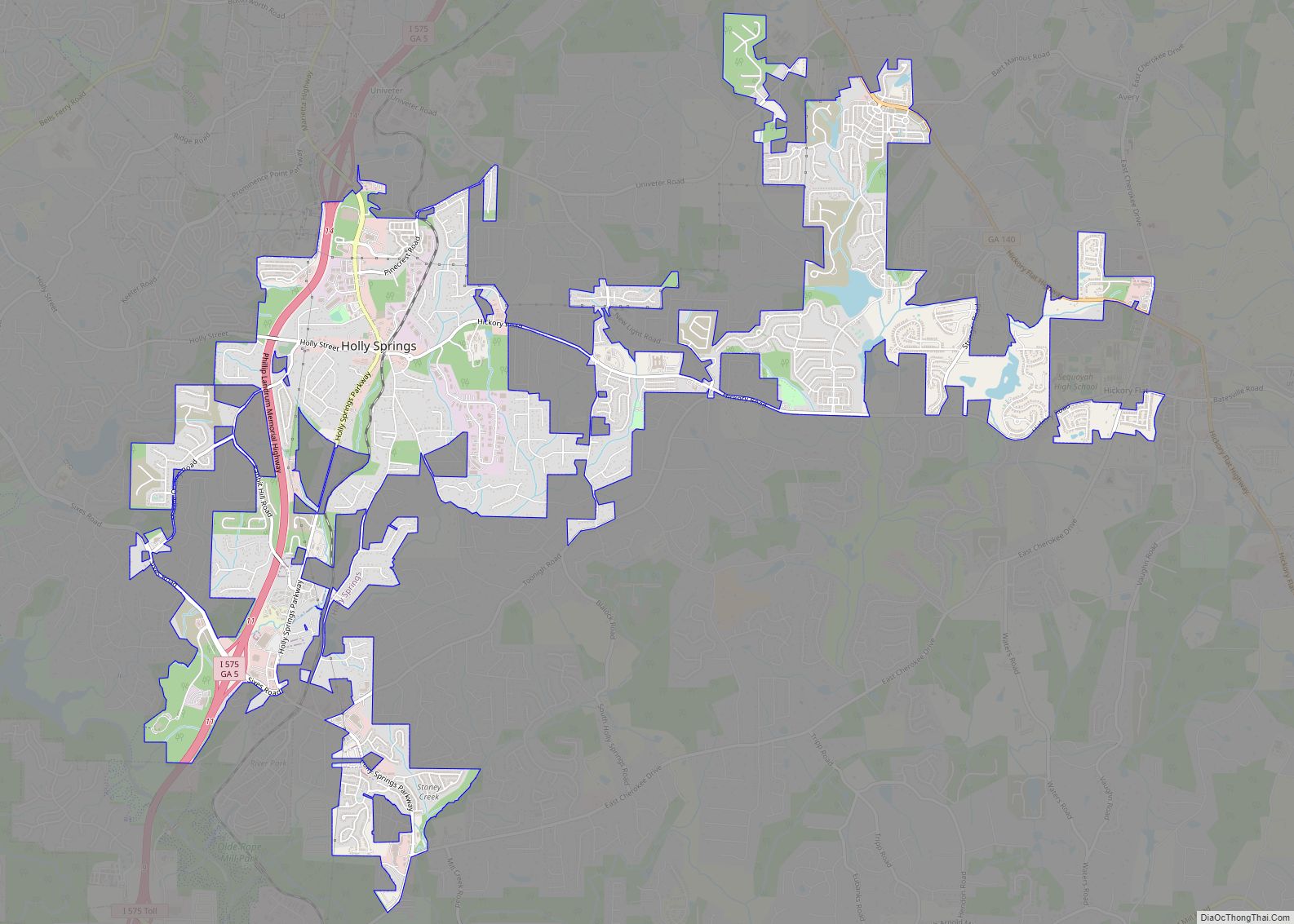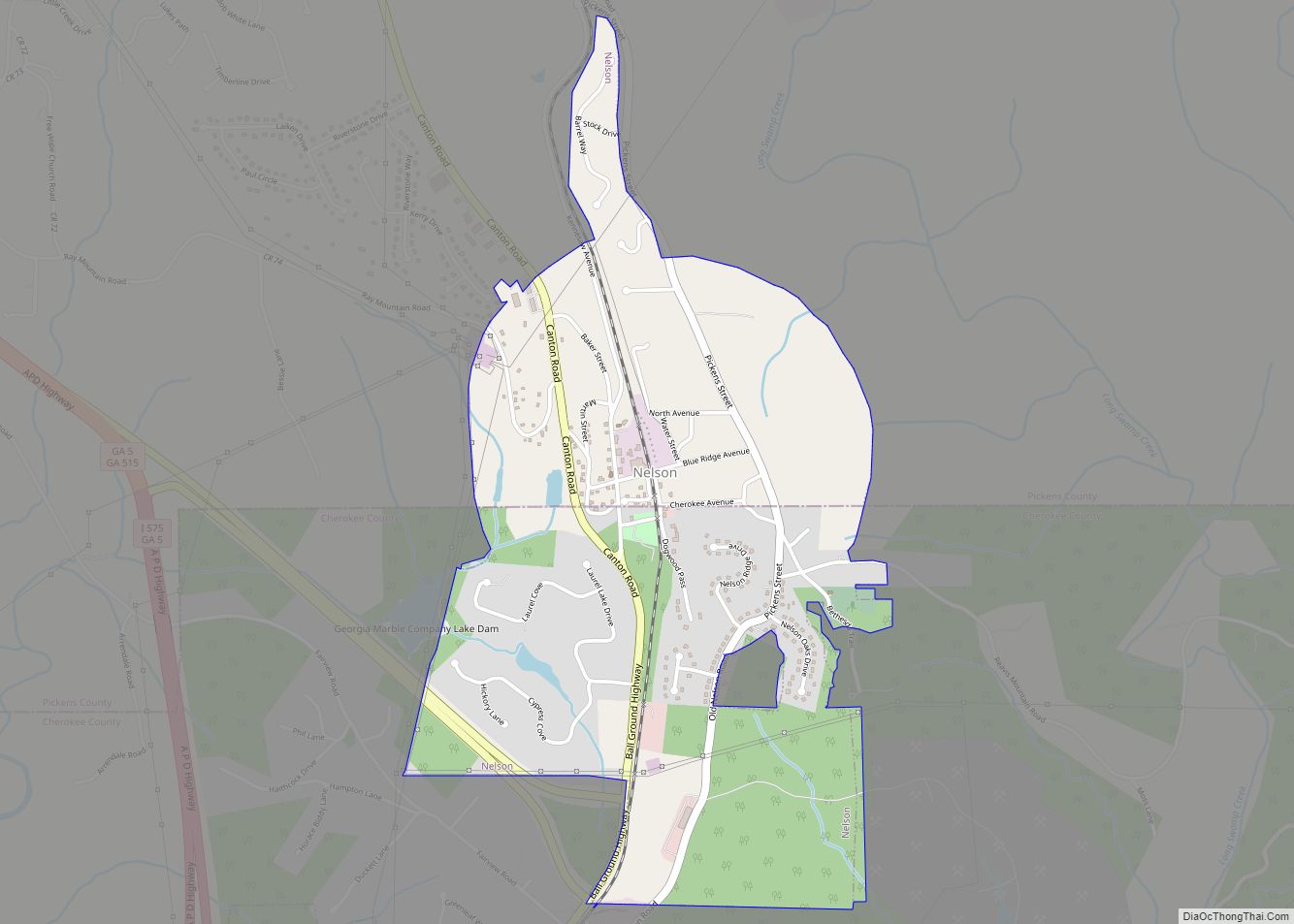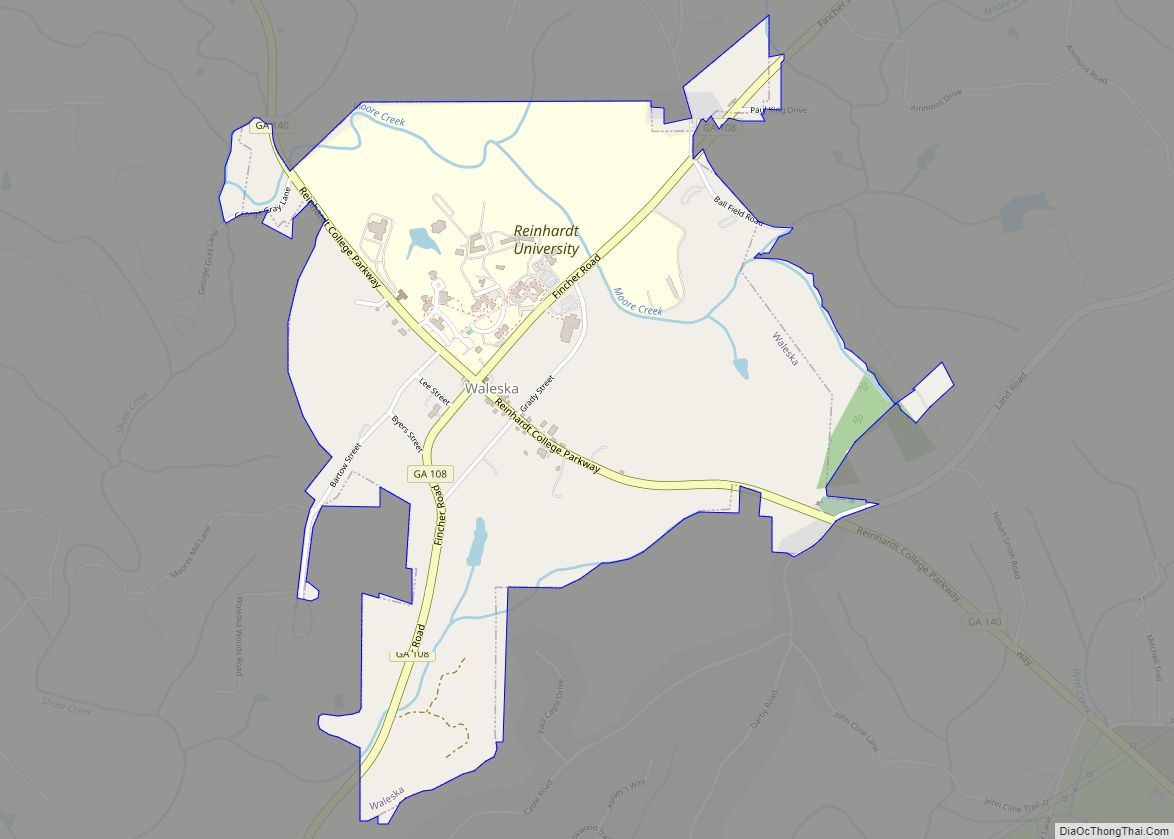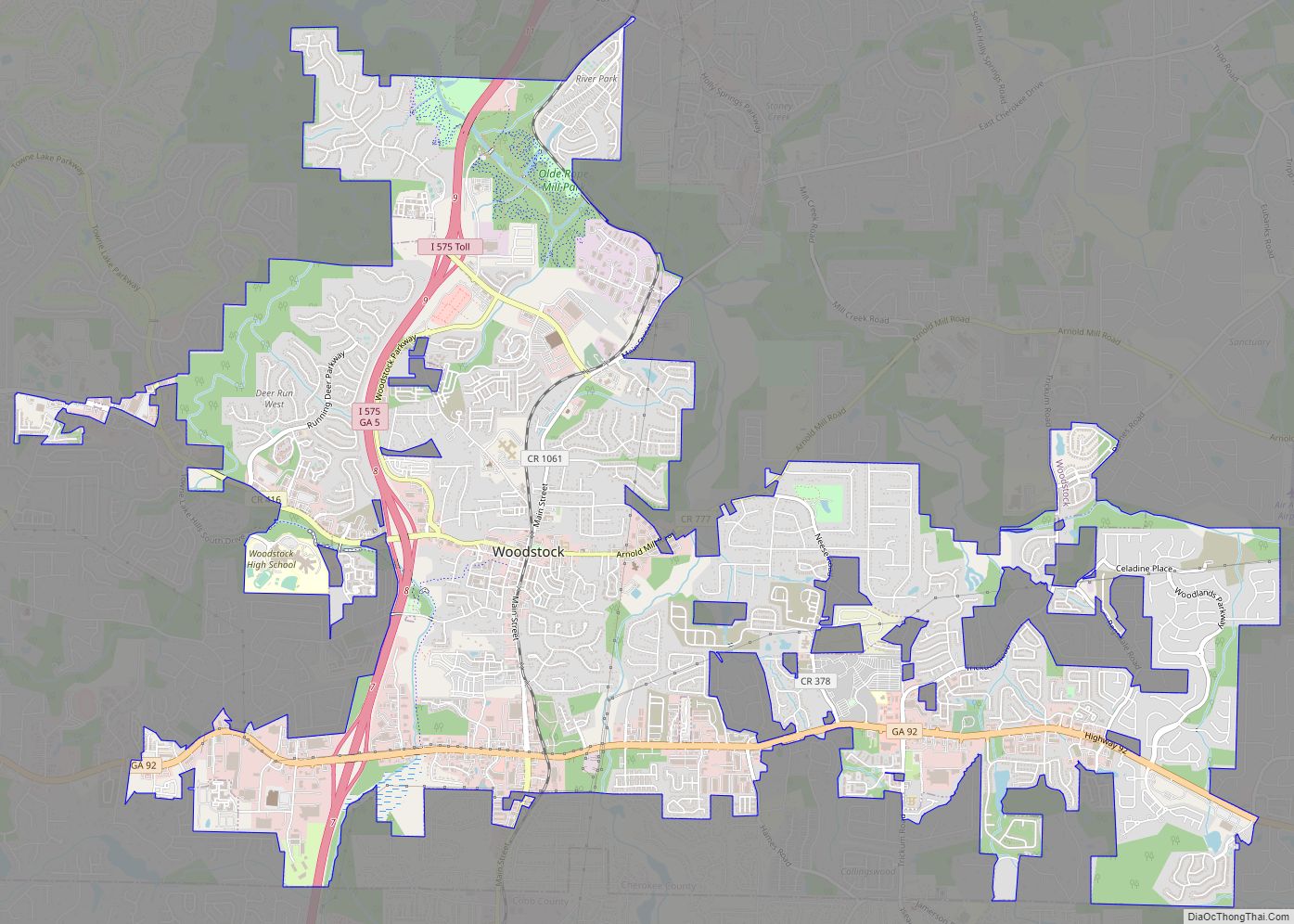Ball Ground is a city in Cherokee County, Georgia, United States. The city was originally Cherokee territory before they were removed from the land and it was given to white settlers. A railroad was built in 1882 and a town was formed around the resulting railroad stop. The town was incorporated on January 1, 1883, and became an industrial-based economy largely centered around its marble industry until around the mid-20th century when the industries began to leave and the city started to decline. From 2000 onwards the city saw rapid growth; as of the 2020 census the city had a population of 2,560, which is over three times the city’s population of 730 in 2000.
| Name: | Ball Ground city |
|---|---|
| LSAD Code: | 25 |
| LSAD Description: | city (suffix) |
| State: | Georgia |
| County: | Cherokee County |
| Elevation: | 1,102 ft (336 m) |
| Total Area: | 6.35 sq mi (16.44 km²) |
| Land Area: | 6.31 sq mi (16.34 km²) |
| Water Area: | 0.04 sq mi (0.09 km²) |
| Total Population: | 2,560 |
| Population Density: | 405.71/sq mi (156.63/km²) |
| ZIP code: | 30107 |
| FIPS code: | 1305036 |
| GNISfeature ID: | 0354443 |
| Website: | cityofballground.com |
Online Interactive Map
Click on ![]() to view map in "full screen" mode.
to view map in "full screen" mode.
Ball Ground location map. Where is Ball Ground city?
History
Early history and settlement
The area that encompasses Ball Ground was originally inhabited by both the Cherokee and the Muscogee Creek, until the Battle of Taliwa, which took place in what later became Ball Ground in 1755, between the Cherokee and the Muscogee Creek, ending with a Cherokee victory and forcing the Creek out of the territory.
Following the passing of the Indian Removal Act in 1830, the Cherokee were slowly relocated out of Cherokee County, including the Ball Ground area. The area of Ball Ground and the surrounding Cherokee County was distributed to European-Americans via the 1832 Georgia Land Lotteries, though the lands were not settled by them until the 1835 Treaty of New Echota caused the Cherokee to fully leave North Georgia and relocate west of the Mississippi River as part of the Cherokee removal out of North Georgia.
The name Ball Ground was initially given by settlers to refer to an area of land, not for the town or community. Native Americans would use the area as a ballground to play a game similar to town ball, and settlers named the town Ball Ground in reference to this. Over time details were added to the story of why the town was named Ball Ground. One such story was that the site was so named because it was the location of a 1532 game of ball between Native Americans playing against Hernando de Soto and his men, in a game umpired by the owner of the Fountain of Youth. When a fight broke out during the game, the umpire was killed, taking the secret of the location of the Fountain of Youth with him. Another story attested as “local folklore” by the Cherokee County Chamber of Commerce says that the site is named Ball Ground because of a game of stickball played between the Cherokee and Creek “for the prize of a thousand square miles of land”.
After acquisition from the Cherokee in the 1830s, Ball Ground was originally settled as farmland and had few people living in the area. By 1847, the Ball Ground area had a post office, which was one of ten post offices within Cherokee County. In 1882, just before the town was established, Ball Ground had six homes and two country stores.
Meetings were held in 1875 in various areas including Ball Ground to discuss the possibility of a railroad being built through Ball Ground and other nearby areas. In 1881 work began on a railroad to Ball Ground using chain gangs for labor and grading on the railroad’s path was completed in Ball Ground that same year. The resulting track was part of the Marietta and North Georgia Railroad and was completed in 1882. Upon completion the terminus of the railroad was the newly constructed depot in Ball Ground.
A town was built around the Ball Ground depot using surrounding land that was donated by thirteen nearby landowners for the express purpose of establishing a town. The deed of transfer to the railroad company noted that “The consideration moving each of us in the establishing of this town is the enhanced value to our lands within and adjacent to the said town, and the general benefit to the country, by which we shall be benefited.” The donated land was split into 200 lots and sold via an auction held in Ball Ground on April 18, 1883, along with other additional properties including a 65 acres (26 ha; 0.102 sq mi) farm and a nearby mill. The next year in 1884, the town had approximately 300 residents.
Incorporation as a town
Ball Ground was incorporated as a town by town charter on September 27, 1883, by an act of the Georgia General Assembly. The town limits were set as “one half mile in every direction from the present railroad crossing on the Gilmer Ferry road; that it shall be known and distinguished as the town of Ball Ground.”
In January 1896 a judge approved the sale of the Marietta and North Georgia railroad to the Atlanta, Knoxville, and Northern railway due to nonpayment of loans by the former railroad. The property to be sold included the depots along the railroad route which included the Ball Ground depot. The plaintiffs in the case were those owed money by the railroad and gave loans that were taken out to charter the railroad, but the scheduled April 1896 sale of the railroad was subsequently delayed through the courts by order of the same judge that initially approved the sale. That same month the Marietta and North Georgia railroad missed their payment deadline and the sale moved forward. On November 1, 1896, the Marietta and North Georgia Railroad was purchased by and turned over to the Atlanta, Knoxville, and Northern railway. Atlanta, Knoxville, and Northern was sold to the Louisville and Nashville Railroad in 1902.
An amendment to the town’s charter was passed in 1903 to change the election times, clarifying the issuance of liquor licenses and set a price for said license at “not less than $500”. The amendment also clarified how ad valorem taxes were to be collected. A further amendment in 1905 changed the 1903 amendment’s $500 liquor license fee to $5,000. An updated charter passed by an act of the Georgia General Assembly in 1911 greatly expanded the powers of the municipal government, including the ability to pass municipal ordinances, and established a school district within Ball Ground.
In 1961 a Ball Ground Improvement Association was formed to add improvements to the city including new paint, a city park, and street lights.
Revitalization
A television documentary aired in December 1971 on North Georgia’s Channel 11 that focused on the city of Ball Ground and described it as a city in decline, and interviewed Ball Grounders about “the slow deterioration of the town.” Two weeks after the broadcast of the documentary, the city’s merchants announced that they had organized the Ball Ground Merchants Association to promote trade and to function as a Chamber of Commerce for the city.
The Ball Ground Community Association was formed in early 1972 to promote the town and to organize festivals and cultural events. The first event the association organized was the May 1972 spring festival and parade, which included a delegation from the Cherokee Nation. This marked the first time the Cherokee returned to the area in any official capacity since they were removed from the area during the 1830s. As part of the festival, two Cherokee teams played a game of stickball against one another, and then-Lieutenant Governor Lester Maddox served as the parade’s grand marshal. Later that year in November 1972, in part because of the festival and other improvements to the city, Ball Ground won the “1972 Stay & See Georgia” contest, which was a program designed to help highlight and expand tourism within the State of Georgia. The spring festival was held annually until 1989.
In 1997 developers began building new homes and communities within Ball Ground. Because of the growth of the city, residents and city officials began discussing the need for an improved sewer system to help modernize the septic systems of older homes and to attract new growth for the city.
In 1998 a plan was put in place to begin work on a $2.8 million sewage system. The sewage system was completed in Fall 2003 amid ongoing development in and around Ball Ground.
Ball Ground Road Map
Ball Ground city Satellite Map
Geography
Ball Ground is located at the foothills of the North Georgia mountains in the northeastern portion of Cherokee County. The city is 4.7 mi (7.6 km) northeast of the city of Canton and 0.4 mi (0.64 km) south of Nelson. It is the northernmost city in Cherokee County that is fully within the county limits, as the city of Nelson is partially within Pickens County. Ball Ground is 37.9 mi (61 km) north of Georgia’s capital city of Atlanta‘s northernmost city limits and 48.7 mi (78 km) from downtown Atlanta.
Ball Ground lies within the Upper Piedmont Physiographic Province in a narrow band of land called the Hightower-Jasper Ridge District, which has a different land structure and lithology than the surrounding areas. The bedrock underneath the city consists of igneous and metamorphic rocks such as gneiss and schist. The land in and around Ball Ground is rich in marble deposits as well as talc, pyrite, and gold.
According to the United States Census Bureau as of 2020, Ball Ground has a total area of 6.3 sq mi (16 km), of which 0.04 sq mi (0.10 km), or 0.63%, is water. The city’s elevation averages around 1,100 ft (340 m) above sea level, ranging from just over 1,000 ft (300 m) in the valleys to around 1,200 ft (370 m) on several hilltops within the city. Unlike most other parts of Cherokee County, Ball Ground is not in a floodplain and has no typically flood prone areas. To protect the water and surrounding lands, the city government has ordinances in place for stream buffer protection, watershed protection, and wetland protection.
Climate
The climate of Ball Ground, as with most of the southeastern United States, is humid subtropical (Cfa) according to the Köppen classification, with four seasons including hot, humid summers and cool winters. July and August are generally the warmest months of the year with an average high of around 85 °F (29 °C). The coldest month is January which has an average high of around 48 °F (9 °C).
Ball Ground receives rainfall distributed fairly evenly throughout the year as typical of southeastern U.S. cities, with March on average having the highest average precipitation at 5.15 in (131 mm), and May typically being the driest month with 3.81 in (97 mm).
See also
Map of Georgia State and its subdivision:- Appling
- Atkinson
- Bacon
- Baker
- Baldwin
- Banks
- Barrow
- Bartow
- Ben Hill
- Berrien
- Bibb
- Bleckley
- Brantley
- Brooks
- Bryan
- Bulloch
- Burke
- Butts
- Calhoun
- Camden
- Candler
- Carroll
- Catoosa
- Charlton
- Chatham
- Chattahoochee
- Chattooga
- Cherokee
- Clarke
- Clay
- Clayton
- Clinch
- Cobb
- Coffee
- Colquitt
- Columbia
- Cook
- Coweta
- Crawford
- Crisp
- Dade
- Dawson
- Decatur
- DeKalb
- Dodge
- Dooly
- Dougherty
- Douglas
- Early
- Echols
- Effingham
- Elbert
- Emanuel
- Evans
- Fannin
- Fayette
- Floyd
- Forsyth
- Franklin
- Fulton
- Gilmer
- Glascock
- Glynn
- Gordon
- Grady
- Greene
- Gwinnett
- Habersham
- Hall
- Hancock
- Haralson
- Harris
- Hart
- Heard
- Henry
- Houston
- Irwin
- Jackson
- Jasper
- Jeff Davis
- Jefferson
- Jenkins
- Johnson
- Jones
- Lamar
- Lanier
- Laurens
- Lee
- Liberty
- Lincoln
- Long
- Lowndes
- Lumpkin
- Macon
- Madison
- Marion
- McDuffie
- McIntosh
- Meriwether
- Miller
- Mitchell
- Monroe
- Montgomery
- Morgan
- Murray
- Muscogee
- Newton
- Oconee
- Oglethorpe
- Paulding
- Peach
- Pickens
- Pierce
- Pike
- Polk
- Pulaski
- Putnam
- Quitman
- Rabun
- Randolph
- Richmond
- Rockdale
- Schley
- Screven
- Seminole
- Spalding
- Stephens
- Stewart
- Sumter
- Talbot
- Taliaferro
- Tattnall
- Taylor
- Telfair
- Terrell
- Thomas
- Tift
- Toombs
- Towns
- Treutlen
- Troup
- Turner
- Twiggs
- Union
- Upson
- Walker
- Walton
- Ware
- Warren
- Washington
- Wayne
- Webster
- Wheeler
- White
- Whitfield
- Wilcox
- Wilkes
- Wilkinson
- Worth
- Alabama
- Alaska
- Arizona
- Arkansas
- California
- Colorado
- Connecticut
- Delaware
- District of Columbia
- Florida
- Georgia
- Hawaii
- Idaho
- Illinois
- Indiana
- Iowa
- Kansas
- Kentucky
- Louisiana
- Maine
- Maryland
- Massachusetts
- Michigan
- Minnesota
- Mississippi
- Missouri
- Montana
- Nebraska
- Nevada
- New Hampshire
- New Jersey
- New Mexico
- New York
- North Carolina
- North Dakota
- Ohio
- Oklahoma
- Oregon
- Pennsylvania
- Rhode Island
- South Carolina
- South Dakota
- Tennessee
- Texas
- Utah
- Vermont
- Virginia
- Washington
- West Virginia
- Wisconsin
- Wyoming
